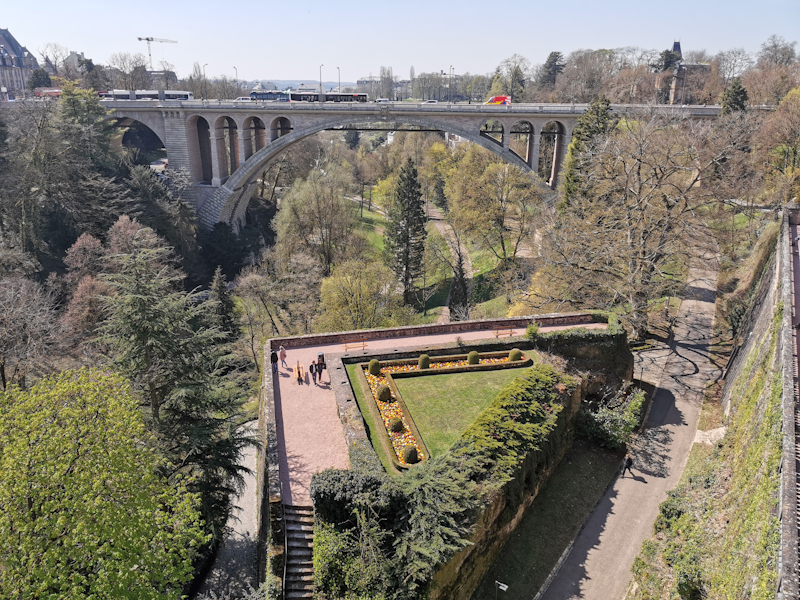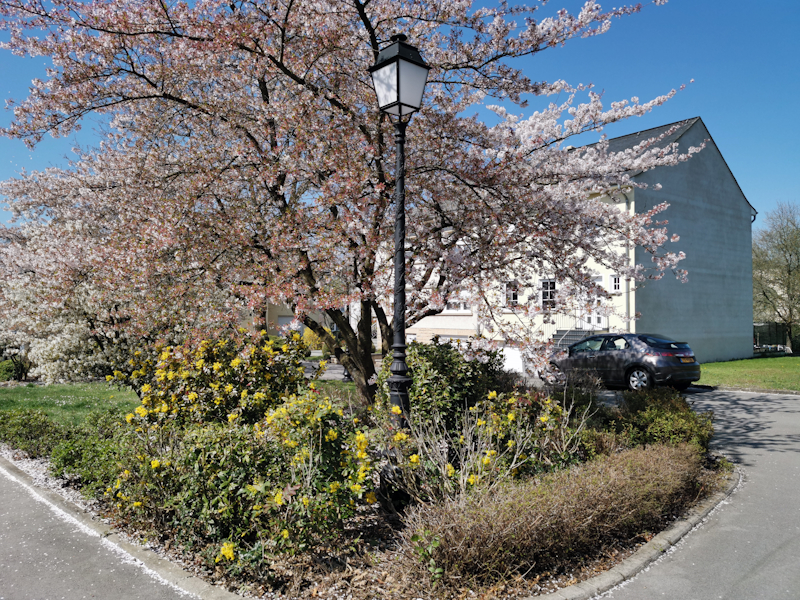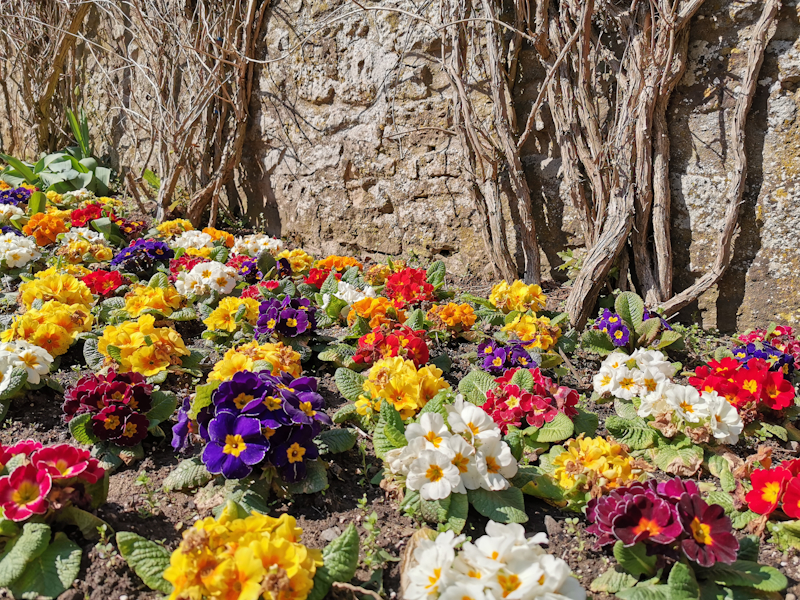The Huawei P30 & P30 Pro Reviews: Photography Enhanced
by Andrei Frumusanu on April 18, 2019 9:00 AM EST- Posted in
- Mobile
- Smartphones
- Huawei
- P30
- P30 Pro
Camera - Daylight Evaluation: Dynamic Range & Detail

[ P30 Pro ] - [ P30 ]
[ P20 Pro ] - [ P20 ]
[ Mate 20 Pro ] - [ S10+ (S) ]
[ S10+ (E) ] - [ S9+ (S) ] - [ G8 ]
[ G7 ] - [ V40 ] - [ View20 ]
[ OnePlus 6T ] - [ Pixel 3 ] - [ iPhone XS ]
Between the four Huawei 40MP sensor phones, the P30 Pro, P30, P20 Pro and Mate 20 Pro all produced vastly different results in their 10MP auto mode. The P30 Pro here produced a quite washed out image which was too desaturated, the P30 on the other hand was nearer to the actual scene. Both results have very different HDR processing compared to the P20 Pro which had a lot stronger processing going for it. The P30s produced more natural luminance gradients with less HDR artefacts.
Looking at the native 40MP results, all the phones have too dark results as the sensors lack dynamic range in this mode. What is also evident is that both the P30 units have trouble with resolving detail as well as the P20 Pro or the Mate 20 Pro. On one hand part of this is explained by the new optics with the wider aperture, particular some shots of the P30 Pro we see the shallower depth of field affecting details. On the other hand, this loss of detail is even present within the focal plane, and here the only explanation I have is that it’s either due to processing or simply the new RYYB sensor which isn’t able to achieve the same colour spatial resolution as the previous generation Bayer sensor.

[ P30 Pro ] - [ P30 ]
[ P20 Pro ] - [ P20 ] - [ Mate 20 Pro ]
[ S10+ (S) ] - [ S10+ (E) ] - [ S9+ (S) ]
[ G8 ] - [ G7 ] - [ V40 ]
[ View20 ] - [ OnePlus 6T ] - [ Pixel 3 ] - [ iPhone XS ]
This next scene with the cherry tree better demonstrates the weaknesses of the optics on the P30 Pro. Its wider aperture of f/1.6 versus the f/1.8 is visible in the outer parts of the image as things get blurred out because of chromatic aberrations. Again, this scene was extremely bright with the sun directly overhead. Both P30s in their native resolution showcase worse optics than the Mate 20 Pro which is able to get clean details throughout the scene without any haze. Again some of the loss in detail can’t be explained just by the optics, and here I think it’s again the sensor which might have a worse DTI implementation has Huawei’s previous 40MP units. These issues aren’t immediately visible in the 10MP shots as things become quite small.
This is a good opportunity to talk about Huawei’s Master AI mode; this had existed in past flagships in various iterations, but now Huawei has finally put a UI button switch directly in the camera interface. Last year this mode was a complete disaster with cartoonish contract and vignette effects, however starting with the Mate 20s it was a lot more toned down. For the P30s, I’ve found that in the vast majority of times it’s beneficial, such as in this sot a slightly bluer sky and a little brighter highlights.

[ P30 Pro ] - [ P30 ]
[ P20 Pro ] - [ P20 ] - [ Mate 20 Pro ]
[ S10+ (S) ] - [ S10+ (E) ] - [ S9+ (S) ]
[ G8 ] - [ G7 ] - [ V40 ]
[ View20 ] - [ OnePlus 6T ] - [ Pixel 3 ] - [ iPhone XS ]
This road scene again shows the optics differences between the P30 Pro, P30 and Mate 20 Pro. The larger aperture of the P30 Pro results in hazy details around the centre of the image, while the P30 doesn’t suffer as much. Still the Mate 20 Pro is far ahead of both in the optics and remains extremely sharp.
Again in the default mode the exposures are a bit too bland for the fact that the sun is directly overhead at noon – the AI mode again brings back a bit of saturation and highlights. Samsung and LG do a lot better here.

[ P30 Pro ] - [ P30 ]
[ P20 Pro ] - [ P20 ]
[ Mate 20 Pro ] - [ S10+ (S) ]
[ S10+ (E) ] - [ S9+ (S) ] - [ G8 ]
[ G7 ] - [ V40 ] - [ View20 ]
[ OnePlus 6T ] - [ Pixel 3 ] - [ iPhone XS ]

[ P30 Pro ] - [ P30 ]
[ P20 Pro ] - [ P20 ] - [ Mate 20 Pro ]
[ S10+ (S) ] - [ S10+ (E) ] - [ S9+ (S) ]
[ G8 ] - [ G7 ] - [ V40 ] - [ View20 ]
[ OnePlus 6T ] - [ Pixel 3 ] - [ iPhone XS ]
In the last scene we again see evident shallow depth of field of both units, with the P30’s focal plane being slightly nearer in this autofocus shot. On the P30 Pro you need to be aware of the new optics, as they can be a double-edged sword. On one hand it can give you natural blurring, but in some cases if you do not want the effect, you can’t do nothing about it, as opposed to say Samsung’s dual-aperture main camera.
The 40MP mode here is useless as while it captures a lot of detail, the dynamic range is severely lacking. Also this scene showcases the bad aspects of the AI mode; colours get far too saturated and unnatural.
P30 Pro & P30 Daylight Evaluation Conclusion
Overall, Huawei’s strategy in their camera hasn’t changed and what we’re seeing in the P30 Pro and P30 in terms of daylight capture continues the trends we saw in the P20s and Mate 20s.
In terms of versatility in different scenarios, the P30s are king. The inclusion of the trifecta of wide angle, regular and telephoto lenses means that you’ll be able to have the right camera at hand in the vast majority of cases. However this was also true for the Mate 20 released late last year.
So how do the P30’s differentiate? Well the P30 doesn’t try to do things much differently, and its camera setup is in line with what we found on the P20 Pro and Mate 20 Pro. This is not to say it’s bad, and the 3x telephoto zoom module is still unique to Huawei.
The P30 Pro’s 5x optical zoom module tries to do something special, and yes indeed it can capture things farther than any other phone out there. I do however have concerns on just exactly how useful this is in everyday usage, as I rarely find myself needing to zoom in quite that far. At 2x digital magnification/crop the P30s still hold up against the optical 2x modules because of the 40MP sensors, however going to 3x zoom we find that the P30 Pro finds itself in a quality gap until you go further to 5x. The bigger concern here is the f/3.4 aperture lens of the new module, and it’s evident that while it gets a lot of detail, its exposure isn’t quite the best.
The wide angle modules on both phones are great, but like on the Mate 20s, the Pro version has a better sensor that is able to capture more detail as well as have better dynamic range.
Processing on the P30s has changed a lot compared to the Mate 20s, however this is not always for a benefit. Sometimes HDR processing is a regression over the Mate 20s, however most of the time it does a better job. Colour rendition is also something the P30s sometimes seem to struggle and I did find some shots a tad too undersaturated, something that in the vast majority of cases is fixed by enabling the AI mode.
Speaking of the AI mode, compared to last year’s P20s, it’s a gigantic leap. This year it’s much more subtle and in the vast majority of cases it’s for the benefit of the scene. It’s only on rare occasions where it does go overboard.
Finally, the main optics of the P30 Pro and P30 feel like a slight disappointment to me. Particularly in the 40MP modes it’s evident that the lenses have seen downgrades compared to what we had in the Mate 20 Pro. The P30 Pro’s large f/1.6 aperture suffers more than the f/1.8 unit of the P30. In 10MP mode this is less immediately visible, however upon closer inspection it does result in less detail even in this mode.
I’m not certain if it’s due to the processing or the sensor, but even within the focal plane we’re seeing less detail sharpness. I very much think this is partly due to the new RYYB sensor which seemingly has lesser DTI (deep trench isolation) between the pixels.
Overall for daylight pictures, I come to the same conclusion I had on the P20 Pro, Mate 20 Pro and View20: These high megapixel sensors do not always achieve the best quality in well-lit scenarios. Huawei also needs to work on the composition consistency between the different camera sensors, there’s too many scenarios where the wide-angle, main camera as well as the zoom lens produce much too different results.










85 Comments
View All Comments
Andrei Frumusanu - Thursday, April 18, 2019 - link
The sensor should be in 4:1 binning mode, otherwise the dynamic range would be much worse.No 10-bit HDR or HDR recording.
4K30: 40Mbps AVC High@5.1 // 25Mbps HEVC High@L5
FHD60: 25Mbps AVC High@4.2 // 16Mbps HEVC Main@4.1
The bit-rates are quite low.
eastcoast_pete - Thursday, April 18, 2019 - link
Thanks Andrei! The low bit rates are unfortunate, and likely hurt the quality of the video. If you still have the P30 Pro, could you try the Android app "Open Camera" and see if that allows for higher bit rate recording?In general, I don't get why so many phone manufacturers are hamstringing even their flagships like that. At least give users the option of recording at higher bit rate. These days, even many affordable mainstream microSD cards support write speeds of 60 Mb/s and up.
Andrei Frumusanu - Friday, April 19, 2019 - link
In Open Camera:AVC tops out at 25Mbps at 4K30 for some reason.
HEVC can be set to 80Mbps in the settings and results in a 62Mbps file at 4K30.
eastcoast_pete - Friday, April 19, 2019 - link
Thanks Andrei! Appreciate it! Any comments on how the 80 Mbps video looked like?I suggested to try this to a. learn what the phone hardware can support and b. hopefully motivate/shame Huawei (and others) with your results to improve their camera software. If Open Camera can go up to 80 Mbps in 4K HEVC recording, the phone is clearly capable of higher bitrates than Huawei uses. As someone interested in digital video, I always want to acquire at the highest bit rate possible, and then compress afterwards (thank you, Handbrake team!). Throwing out data is easy, re-creating details is hard or impossible. Also, higher bit rates generally reduce compression artifacts.
s.yu - Friday, April 19, 2019 - link
Hey Andrei, I've been looking at the 40MP shots of the P20P, 30P, and Mate20P, and a very peculiar thing I noticed is that both the P20P and 30P have false color interpolation artifacts, while the Mate20P avoids that; but in terms of chroma noise, Mate20P and P30P are on the same level, while in terms of texture aggregation, the P20P and Mate20P behave similarly.So the suppression of the interpolation artifacts doesn't seem to be due to chroma NR, nor is it in any way correlated to sharpening, *nor is it CFA-bound*, as the P20P shares a CFA with Mate20P while P30P uses RYYB. So do you have any idea why this might be?
I've been examining the area below the left half of the bridge for chroma noise and the pale-looking tree there exhibits a lot of interpolation artifacts in the P20P/30P shots:
https://images.anandtech.com/galleries/7027/P30Pro...
https://images.anandtech.com/galleries/7027/Mate20...
https://images.anandtech.com/galleries/7027/P20Pro...
Andrei Frumusanu - Friday, April 19, 2019 - link
I think all of it is just results of the lens; if you check the centre of other images they all look fine, but it gets worse and worse off-centre for the P20P and P30P.s.yu - Friday, April 19, 2019 - link
Hmmm, I couldn't think of an optical artifact with that kind of behavior...I don't think CA would be especially evident on foliage especially when the lighting of the scene renders it very low contrast. Basically in that really typical scene you're seeing blobs of other colors (which are not actually present) in a cloud of yellowish green.I chose another set and this time there's orange artifacts in the green bush in the center of the scene possibly with magenta artifacts in white or very faintly pink flowers slightly above it(the generally uniform color of the petals seem artificially "split" by the P30P between magenta and white, but I'm not really sure), again neither are visible on bayer or Mate20P.
https://images.anandtech.com/galleries/7025/P30Pro...
https://images.anandtech.com/galleries/7025/Mate20...
https://images.anandtech.com/galleries/7025/Pixel3...
It isn't so obvious in the P20P shot, but the severe texture aggregation rendered it impossible to tell. Usually for these artifacts to show, the pattern's frequency has to be high enough.
Andrei Frumusanu - Friday, April 19, 2019 - link
It's hard to separate sensor effects from post-processing effects. Another thing to take into account is that the P30P sends RYYB data directly to the ISP where things get recomputed. It can be either a DTI issues on the sensor, an ISP recombination issue, or simply a senseless noise reduction filter.neothe0ne - Thursday, April 18, 2019 - link
It looks like the speaker evaluation is missing from the review?Andrei Frumusanu - Thursday, April 18, 2019 - link
I'll be re-adding that soon / tomorrow, I wanted to add a part regarding stereo separation.In general the speaker is good, however it's still a mono bottom firing speaker.